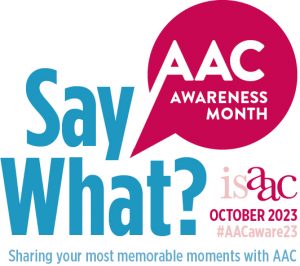AAC Awareness Month 2023
Welcome to our global AAC community!
International AAC Awareness Month was established by ISAAC’s LEAD Project Committee in October 2007. Thirteen countries participated in the first Awareness Month and events have been increasing in number and scope ever since.
Today, International AAC Awareness Month is celebrated around the world each October. The goal is to raise awareness of augmentative and alternative communication (AAC) and to inform the public about the many different ways in which people communicate using communication devices.
Activities vary from country to country. Awareness days and social events, such as morning or afternoon teas and open houses, help create a sense of community. International events, such as published collections of stories, videos and songs, are other exciting ways that people have come together in past years promote AAC awareness.
The 2023 theme is “Say what? Sharing your most memorable moments with AAC.” “Say what?” is shorthand (American English) for the more general phrase “What did you say?”. You can use the more general phrase as an alternative for better translation in other languages. We’ve translated both phrases for you into several languages. You can see the translations here.
What is this theme about?
Oftentimes with AAC, unexpected things happen while learning, using, supporting, and researching. We would like for you to share those stories with the world.
Say What?
Scroll to see just a few of the things people are sharing for AAC Awareness Month 2023. And be sure to follow on social media, where you’ll see so much more! #AACaware23
Debunking the Myths of AAC
By Chelsea Hagen
My name is Chelsea Hagen, and I use an AAC Device to help me communicate. I am a writer, and I enjoy creating dark but comical stories with an unexpected twist. I live near Breton, Alberta, and I am a student at the University of Athabasca studying for my Bachelor of English degree. I want to be like most authors and have the bio on the back of the book saying that I attended university. Some of things I enjoy, besides writing, are reading, cooking, antiquing, crafts, Broadway plays, movies, fishing, and bowling. My dream is to someday be known as a famous writer. I have had a few poems and articles published, and I’ve also made a couple short films. I have just written an illustrated children’s book about a cat and a ball of wool, and I am hoping it will be picked up by a publisher.
Outside of my passions and ambitions, I am also the PWUAAC board member for ISAAC Canada. If you are wondering what my role is as the PWUAAC board member, it’s not the person who brings the snacks. It is a person who uses an AAC device or, as I call myself, the defender. I am also an ISAAC International lead.
Now that you know more about me as a person, I wanted to debunk the myths of an AAC communicator. The list I have is in no particular order because they are all equally important. I also want to mention that I use the term AAC device communicator as I’m not fond of the word AAC user. It’s not like a drug addiction – well maybe a little, I have been known to turn a light shade of green from using my device for a long period of time. Jokes aside, I prefer to refer to it as a communication device. Knowing that, let’s get to the myths.
Myth number one: AAC device communicators are all the same. No, we are not all the same. We areeach an individual. I am nothing like Steven Hawking, but wow when I meet people do they love to tell me I am just like him. He was an old science man with completely different interests from mine. Yet my grade 12 principal, as a graduation gift, gave me a bunch of Steven Hawking books. An AAC device communicator is still an individual. We have our own interests, opinions, likes and dislikes. I ask you to please see us and not just our devices. Let us make our own decisions and travel our own personal road.
Myth number two: AAC device communicators do not learn to read and cannot spell. We can learn to read. I learned to read. It was not an easy feat, and I am only at an average reading level, but I really enjoy reading books. When I left high school, I was at a very low reading level and the school felt that I had reached my peak reading level. Please, if you are told your child cannot learn to read, don’t believe them. After graduation I worked for five years to get my reading to a grade six level. I’m not going to lie, it was a lot of sweat and tears from both my mom and me. Even now, if I don’t read almost every day, I will fall back on my reading level. I also want to take a moment to mention that spelling is the hardest task for me. I used Minspeak, which is an icon based AAC device right up until last year and then I made the decision to switch to only using a keyboard. I still struggle with spelling, and I know I always will, but I feel this is not because I am an AAC device communicator. I actually blame my parents and their terrible spelling genetics. In fact, people always think my mom has a teaching background, but no, she is an accountant. Some days I am the one to correct her spelling and punctuation.
Myth number three: Secondary Education is not an option for AAC communicators. When COVID began, pretty much the whole world went online and it was a benefit for an AAC communicator as more options became available. Chats and Zoom are now set up for an AAC communicator and every two weeks I can talk with other AAC communicators from around the world. I am also now able to take my time and get my Bachelor of English online. I was told once that if you do your degree online you will miss out on the university experience. My response was that I will really miss out on sitting there by myself during breaks watching everyone on their phones and not talking to each other. The opportunity to experience the typical university experience is not appealing to me. Being able to be online reduces my stress level because I can work at my own pace. I am a two-switch user, and it takes me a long time to write. I average about three words a minute. This leads me to the next myth.
Myth number four: All AAC communicators should use eye gaze. This is so popular right now, but it is not for everyone. I have tried many different eye gazers, and they just don’t work for me. Unfortunately, the eye gaze doesn’t pick up my eyes even though I wish it did. I know it would be faster as I am a fast scanner but in reality, scanning can be as slow as ketchup running out of a new bottle. I use my device everywhere and at all different angles. For example, I use it down bumpy goat trails and I like to write outside under my favorite tree in the backyard. I am also a shaker and a mover so when it comes to me, I’m faster and talk way more with my two switches than I do with eye gazing. The reason I have two switches with cords is that I scan fast and Bluetooth switches have a slight delay. It can take a bit to find the right fit. If the device is not effective, please don’t forget to try all methods of accessing the device before making the decision that the person just was not smart enough to use a device.
Myth number five: If my child uses an AAC device they will not learn to speak. I have a quick answer to this one. Learning an AAC device is not easy. If I could talk, I would. I never give up trying to use my throat voice, but using an AAC device supports speech, and it allows one’s personality to shine.
Myth number six: An AAC device communicator is not a sociable person. I love socializing but it is a challenge because conversations move fast, and I can’t keep up. That doesn’t mean I am not a social butterfly. If I am given the time, most people find me to be a bit chatty with a witty personality.
Myth number seven: An AAC device communicator is not intelligent. Boy, do I know this myth well. When I stay at a hospital and don’t have my device it’s like going back in time. I am treated like I am deaf, mute, and dumb. It’s not until I am up in my chair with my device that the staff then believe that I can understand them. People need to be educated that nonverbal does not equal unintelligent.
Myth number eight: An AAC device communicator doesn’t need to be able to use ‘adult language.’ It’s not true. I have friends that use AAC devices, and they swear like a sailor. I’m not someone who swears regularly but I do firmly believe it should still be an option just as it is for everyone else. As kids grow and become adults, the language in their devices should grow too. I have an emoji display in my device and it doesn’t have the middle finger. As an adult I want the option of an emoji with a middle finger.
Myth number nine: AAC communicators are sometimes dreamy heads that do not listen. I will admit that I am a bit of a dreamy head, as are many writers, but most times when it seems like I am not listening it’s because I am busy multi-tasking. If you ask me a question, I must remember the question and find my icons or letters to answer the question. If you ask me a second question before I’m finished the first one, my brain starts to overload. We just need time and patience from you.
Finally, myth number ten: We are happy to have our robot voices. I have a difficult time with this one. I know I should be so grateful to have a voice, don’t get me wrong, but why does it have to sound so much like a robot? I hate my American West Coast girl voice, but it’s a bit different than the rest of my AAC girl friends’ voices so that is what I use. My device doesn’t have a Canadian voice and does not represent my natural dialect. What I don’t understand is how a poor grandma can get ripped off by some guy that sounds like her grandson, or why Microsoft Word has such lovely natural voices, and yet I am stuck with this horrible robot voice. We need a natural voice with a number of options. This way we can sound like the individuals that we are.
There are more myths out there to tackle, but that is it for this article. I hope that I have helped to clear up some of the stigmas that surround AAC device communicators. Thank you for taking the time to further educate yourself about AAC devices and their communicators and for reading about my own experiences and views. I am an AAC device communicator, but I am also an individual, just as all AAC device communicators are, and just as you are.

Visit the CENMAC website to see Abdi’s Top Tips for AAC Awareness, including a video and posters you can download, as well as other stories and resources to support AAC users. |
Follow @CALLScotland for videos like this one, as well as blogs and other resources. |
|

Watch this short video in which some of the AAC professionals, users, and parents on the Assistiveware team share their personal perspective. |
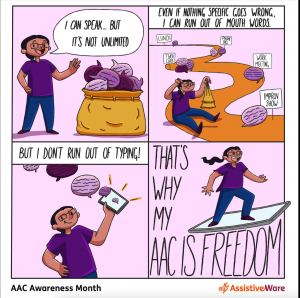
From Assistiveware, a comic illustrating what AAC means to one of their own part-time AAC users. |
|
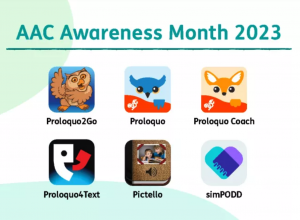
Assistiveware is offering a discount on its AAC apps. The offer will run from October 10 to 17, 2023. Check out the full list of the apps on offer and the offer’s details. |

Watch this video from ABUHE Adult Speech and Language Therapy where Adult AAC lead Natalie talks about AAC. |
|
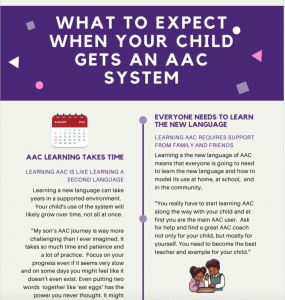
From Technology and Language Center, Inc.: In honor #augcomm #AAC Awareness Month, we’re sharing a new infographic! In this parent-professional collaboration, TALC families share what they wished they’d known about AAC. Download the full infographic and other parent handouts free from our website bit.ly/TALC_Freebies |
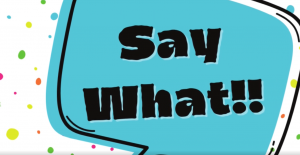
Check out this video from Coomera State Special School #AACaware23 October is AAC Awareness Month! This is a chance to highlight the different ways we communicate. The theme is “Say what?”. The Special Schools in the region are celebrating by sharing memorable moments with AAC in our schools throughout October. Visit their Facebook page for more! |
|

From Helen Robinson, SLT: Following on from my poster presentation at #CM23conf and as part of #AACaware23 month, I’m please to share The Positive AAC Framework. Building on the 4 P’s of AAC model, this framework was developed with input from AAC users, families and practitioners. See the poster here.
|
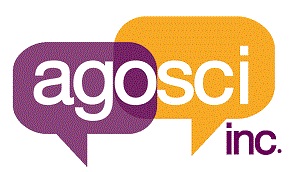
Visit AGOSCI’s website to see AAC Awareness Month resources, including online webinars. |
|
|
Learn more about Augmentative and Alternative Communication (AAC) with an ‘Introduction to AAC’ from Speech in a sec. |
The Center for Augmentative and Alternative Communication started off AAC Awareness Month with a webinar entitled Multilingualism & AAC presented by Prof Kerstin Tönsing. Listen to the YouTube recording. |
|
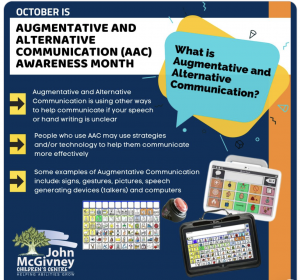
From the John McGivney Children’s Centre: It’s Augmentative & Alternative Communication (AAC) Month. Thanks to our fantastic #AAC team for supporting children, youth & their families each & every day! Learn more about their work on our website: http://ow.ly/bT2N50L4Gaw |
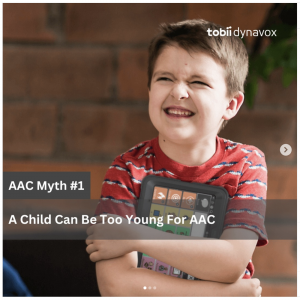
Follow Tobii Dynavox UK on Instagram for their AAC Awareness Month series of AAC mythbusters! |
|

The First Social Welfare Foundation in Taiwan held “The First AAC Video Creation Competition.” Learn more here. |
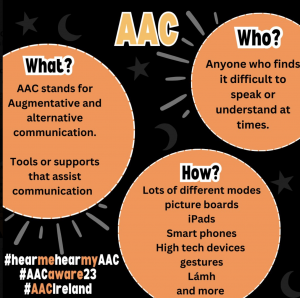
From Trinity College Dublin,@ClinSpeechTCD |
|
|
ISAAC LEAD member Chelsea Hagen and her Sexy Robot Voice Army crew is back at it with another holiday video: “It’s not me… It’s my device that’s haunted,”, something every augmented communicator can relate to with using their device. Good evening, good people.
|
